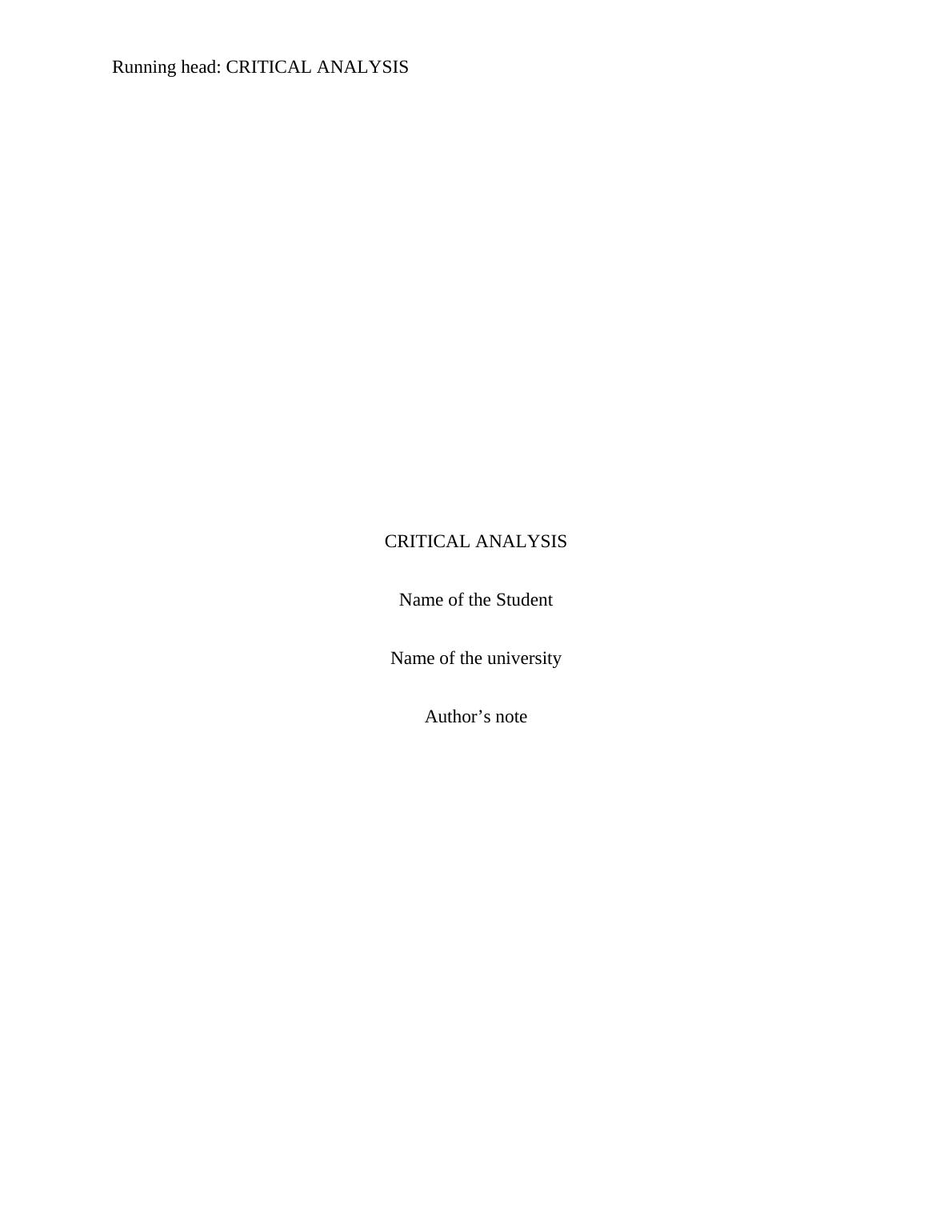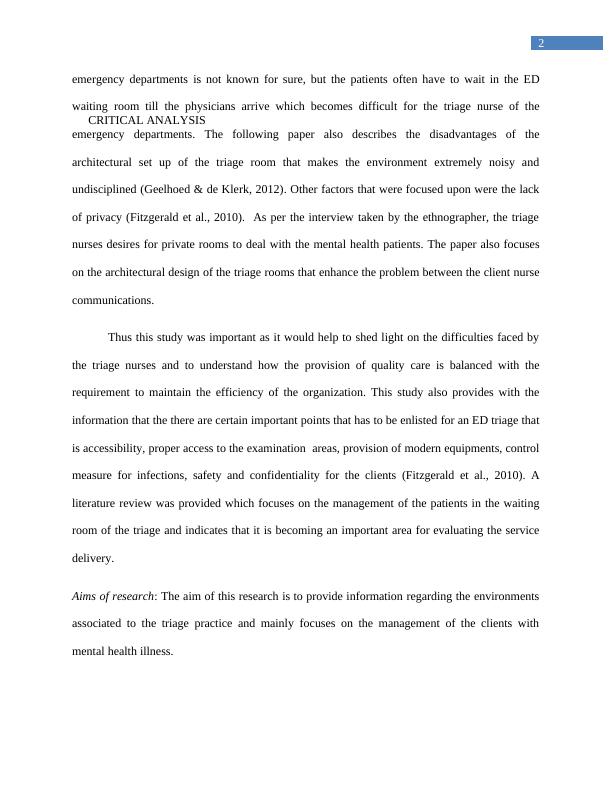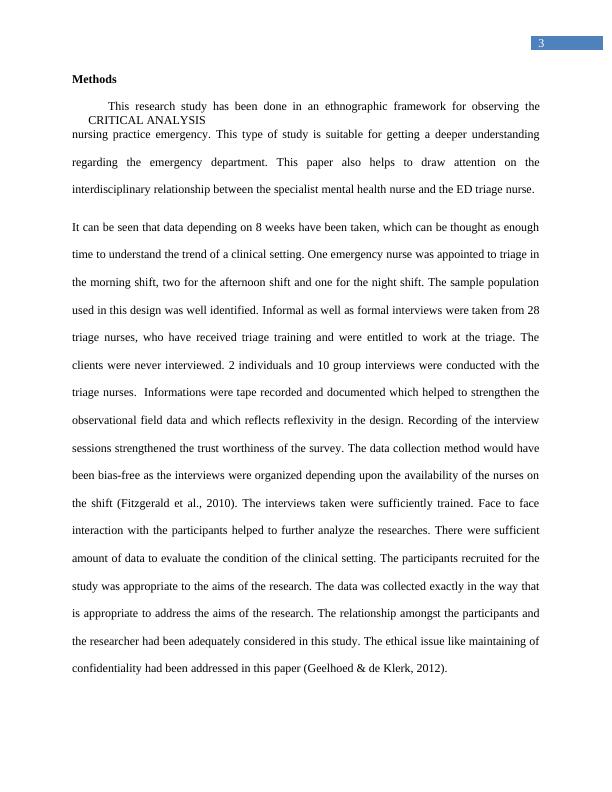Critical Analysis Assignment (Doc)
12 Pages3010 Words64 Views
Added on 2020-05-11
Critical Analysis Assignment (Doc)
Added on 2020-05-11
ShareRelated Documents
Running head: CRITICAL ANALYSIS CRITICAL ANALYSIS Name of the StudentName of the universityAuthor’s note

1CRITICAL ANALYSIS IntroductionEmergency department across the world follow a triage system in order to manage theovercrowding in the department. An emergency triage basically improves the emergency careand to sort out the cases on the basis of urgency. This qualitative paper provides with anobservational ethnographic approach to examine the problems faced in assessing mental healthpatients in the triages of the emergency department. It is a moderately regarded journal having the cite score 0.15.This journal has been published in Australia. The journal provides us with an insight of the usualproblems that are faced in emergency tried for accessing the mental health patient, which wouldhelp to develop the evidence based nursing interventions that has to be conducted to mitigate theproblems faced by the triage nurses. The authors of this article are Marc Broadbent, who is a registered nurse and contains aPhD in nursing from the school of nursing and Midwifery, Australia. Second author is LornaMoxham, who is a mental health nurse and holds a PhD degree and belongs to the School ofnursing, Midwifery and Indigenous health, NSW and Trudy Dwyer, who is also an RN having aPhD degree and belongs to the School of Nursing and Midwifery, Central QueenslandUniversity, Australia.BackgroundThe key points described to give the background of this paper are that the Australianemergency departments are the main centre for the clients having mental health illness in orderto access acute health care. Although the exact number of the mental health presentations in the

2CRITICAL ANALYSIS emergency departments is not known for sure, but the patients often have to wait in the EDwaiting room till the physicians arrive which becomes difficult for the triage nurse of theemergency departments. The following paper also describes the disadvantages of thearchitectural set up of the triage room that makes the environment extremely noisy andundisciplined (Geelhoed & de Klerk, 2012). Other factors that were focused upon were the lackof privacy (Fitzgerald et al., 2010). As per the interview taken by the ethnographer, the triagenurses desires for private rooms to deal with the mental health patients. The paper also focuseson the architectural design of the triage rooms that enhance the problem between the client nursecommunications.Thus this study was important as it would help to shed light on the difficulties faced bythe triage nurses and to understand how the provision of quality care is balanced with therequirement to maintain the efficiency of the organization. This study also provides with theinformation that the there are certain important points that has to be enlisted for an ED triage thatis accessibility, proper access to the examination areas, provision of modern equipments, controlmeasure for infections, safety and confidentiality for the clients (Fitzgerald et al., 2010). Aliterature review was provided which focuses on the management of the patients in the waitingroom of the triage and indicates that it is becoming an important area for evaluating the servicedelivery. Aims of research: The aim of this research is to provide information regarding the environmentsassociated to the triage practice and mainly focuses on the management of the clients withmental health illness.

3CRITICAL ANALYSIS MethodsThis research study has been done in an ethnographic framework for observing thenursing practice emergency. This type of study is suitable for getting a deeper understandingregarding the emergency department. This paper also helps to draw attention on theinterdisciplinary relationship between the specialist mental health nurse and the ED triage nurse.It can be seen that data depending on 8 weeks have been taken, which can be thought as enoughtime to understand the trend of a clinical setting. One emergency nurse was appointed to triage inthe morning shift, two for the afternoon shift and one for the night shift. The sample populationused in this design was well identified. Informal as well as formal interviews were taken from 28triage nurses, who have received triage training and were entitled to work at the triage. Theclients were never interviewed. 2 individuals and 10 group interviews were conducted with thetriage nurses. Informations were tape recorded and documented which helped to strengthen theobservational field data and which reflects reflexivity in the design. Recording of the interviewsessions strengthened the trust worthiness of the survey. The data collection method would havebeen bias-free as the interviews were organized depending upon the availability of the nurses onthe shift (Fitzgerald et al., 2010). The interviews taken were sufficiently trained. Face to faceinteraction with the participants helped to further analyze the researches. There were sufficientamount of data to evaluate the condition of the clinical setting. The participants recruited for thestudy was appropriate to the aims of the research. The data was collected exactly in the way thatis appropriate to address the aims of the research. The relationship amongst the participants andthe researcher had been adequately considered in this study. The ethical issue like maintaining ofconfidentiality had been addressed in this paper (Geelhoed & de Klerk, 2012).

End of preview
Want to access all the pages? Upload your documents or become a member.
Related Documents
Evidence Based Nursing - PDFlg...
|11
|3009
|222
Evidence-Based Health Research and Practicelg...
|16
|2803
|75
Evidence Based Nursing - Assignmentlg...
|12
|2907
|163
Report on Research Article Relevant to Nursing Practicelg...
|11
|2886
|159
Critical evaluation of the qualitative study on impact of emergency department triage environment on the triage practice for mentally-ill clients: in an Australian contextlg...
|13
|3145
|178
Emergency Department Triage Analysis (Doc)lg...
|13
|3329
|339
